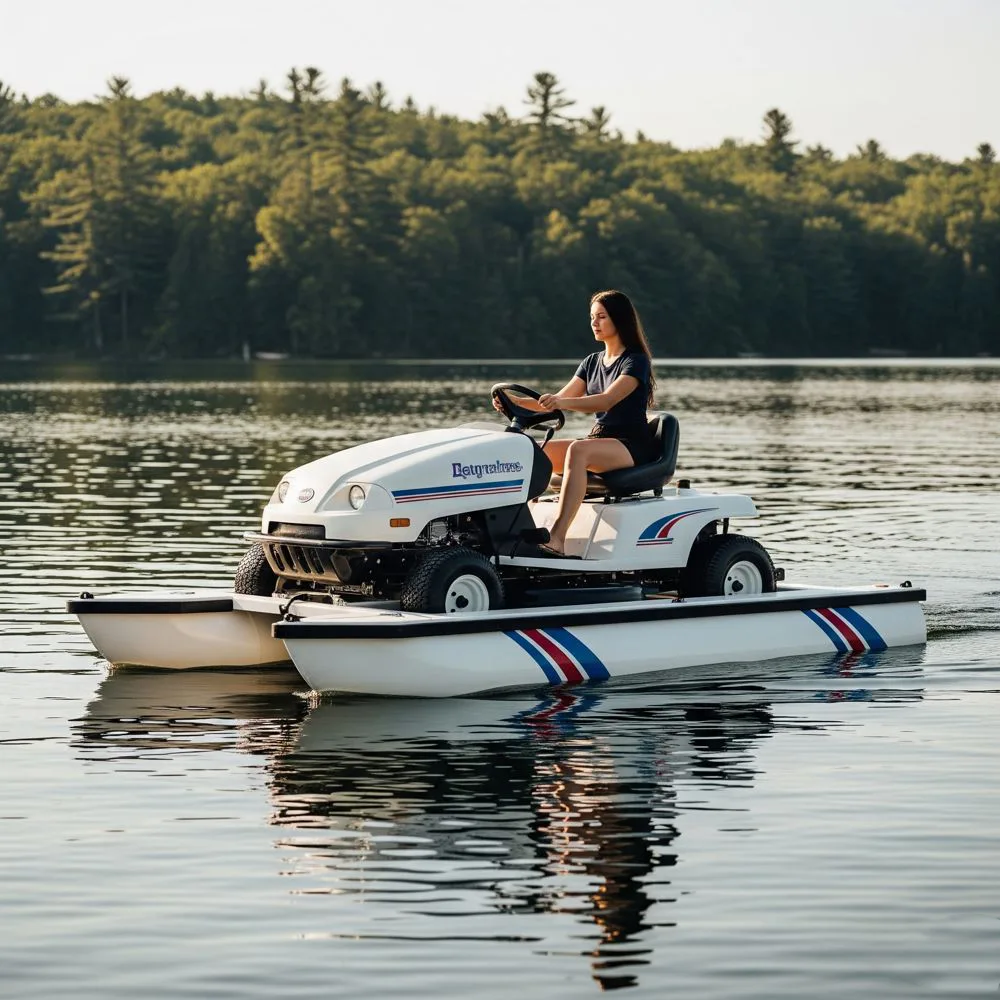The world of recreational boating has witnessed countless innovations, but few capture the imagination quite like the lawnmower pontoon boat. This ingenious creation represents the perfect marriage of practicality and creativity, transforming ordinary lawn maintenance equipment into an extraordinary water vessel. Whether you’re seeking an affordable entry into boating or simply love the thrill of building something unique, a lawnmower pontoon boat offers an exciting project that combines engineering, craftsmanship, and pure fun.
The concept has gained tremendous popularity among DIY enthusiasts, particularly those who appreciate the challenge of repurposing everyday items into functional watercraft. This innovative approach to boat building demonstrates that with creativity, basic tools, and determination, anyone can create their own custom water vessel without breaking the bank.
What Is a Lawnmower Pontoon Boat?
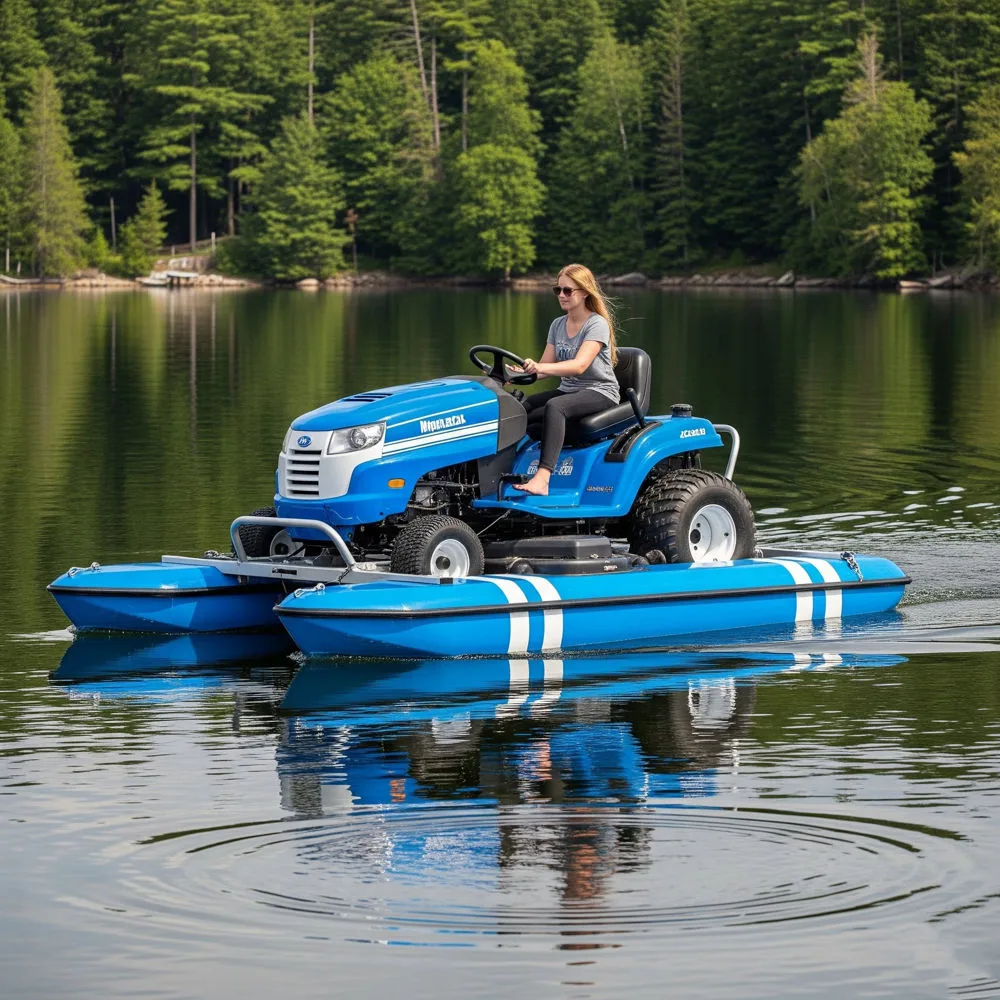
A lawnmower pontoon boat is exactly what it sounds like: a floating platform that uses a modified lawnmower as its primary propulsion system. The basic design involves mounting a riding lawnmower or walk behind mower onto a stable pontoon platform, creating a unique hybrid vessel that can navigate calm waters with surprising effectiveness.
The beauty of this design lies in its simplicity and accessibility. Most lawnmowers already possess the essential components needed for boat propulsion: a reliable engine, a transmission system, and steering mechanisms. By adapting these existing features and mounting them on a buoyant platform, builders can create a functional watercraft at a fraction of the cost of traditional boats.
These vessels typically feature twin pontoons or a single wide platform for stability, with the mower mounted securely in the center. The mower’s cutting deck is removed and replaced with a marine propeller system, while the steering and throttle controls remain largely unchanged. The result is a quirky yet functional boat that turns heads wherever it goes.
Planning Your Lawnmower Pontoon Boat Build
Essential Design Considerations
Before diving into construction, successful builders must carefully consider several crucial design elements. The first consideration is size and capacity. Your lawnmower pontoon boat should be designed to accommodate its intended passengers while maintaining proper weight distribution and stability. Most builds comfortably seat two to four people, depending on the pontoon size and mower specifications.
Stability remains paramount in any boat design, and pontoon boats excel in this area due to their wide beam and distributed buoyancy. When planning your build, consider the placement of the mower engine, passenger seating, and any additional equipment. The goal is to maintain a low center of gravity while ensuring adequate freeboard to prevent water intrusion.
Choosing the Right Lawnmower
Selecting the appropriate mower forms the foundation of your project. Riding mowers typically work best due to their integrated steering systems and comfortable operator positions. Look for models with reliable engines, preferably air cooled units that can handle marine environments better than liquid cooled systems. Horizontal shaft engines adapt more easily to marine propeller systems than vertical shaft models.
The mower’s transmission system also deserves consideration. Hydrostatic transmissions offer smooth speed control and reverse capability, making them ideal for marine applications. Manual transmissions can work but may require additional modifications for optimal boat operation.
Pontoon Platform Selection
The pontoon platform serves as your boat’s foundation, so choosing the right materials and design is critical. Aluminum pontoons offer excellent corrosion resistance and lightweight construction, making them popular choices for DIY builders. Steel pontoons provide strength and durability but require proper treatment to prevent rust in marine environments.
Some builders opt for homemade pontoons constructed from sealed drums, PVC pipe, or foam filled chambers. While these options can reduce costs, they may compromise safety and performance compared to purpose built marine pontoons. Whatever material you choose, ensure adequate buoyancy to support the combined weight of the mower, passengers, and equipment with a substantial safety margin.
Construction Process and Techniques
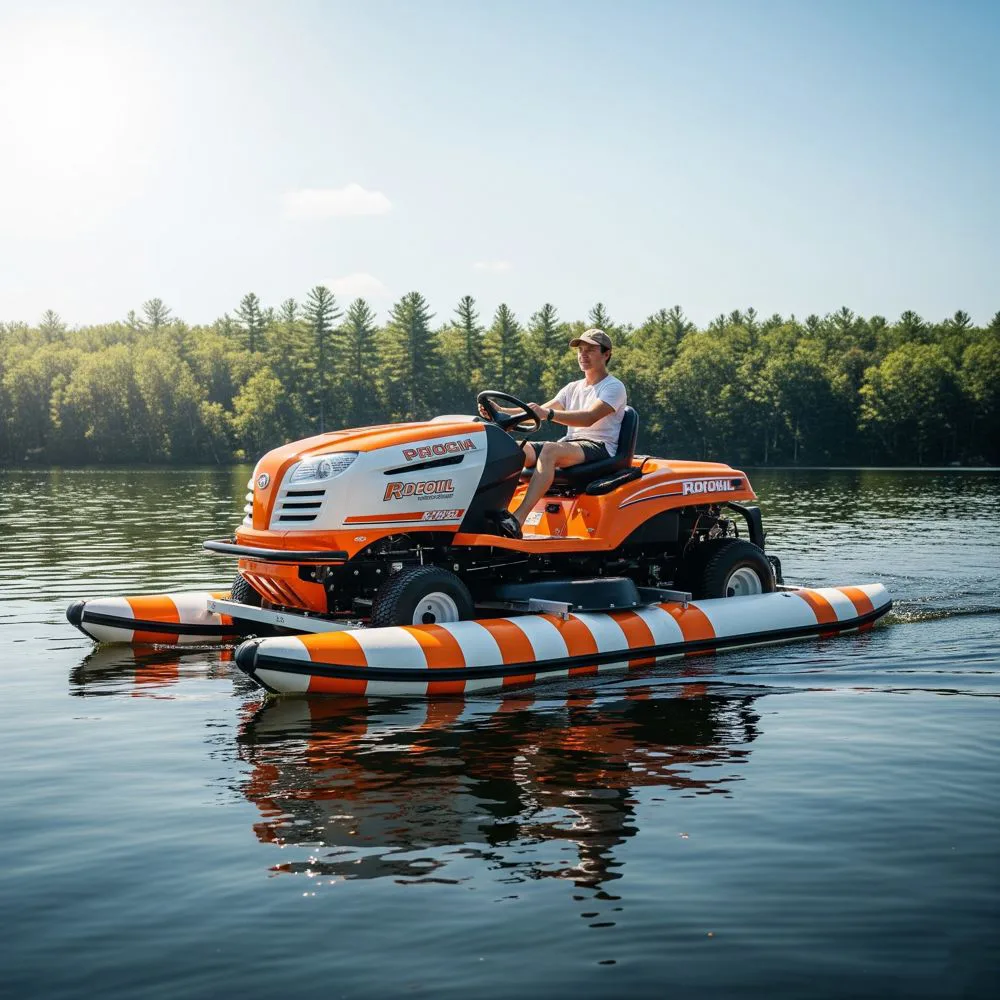
Frame Assembly and Mounting
The construction process begins with creating a robust frame to connect the pontoons and support the mower. Most builders use aluminum or steel tubing to create a rectangular frame that spans between the pontoons. This frame must be engineered to handle the mower’s weight and operational stresses while providing mounting points for seats, controls, and safety equipment.
Proper mounting of the mower requires careful consideration of weight distribution and accessibility for maintenance. The mower should be positioned to maintain the boat’s balance while allowing easy access to the engine and transmission. Many builders create a removable mounting system that allows the mower to be easily removed for maintenance or winter storage.
Propulsion System Adaptation
Converting the mower’s cutting system into marine propulsion represents the most technical aspect of the build. The cutting deck must be completely removed and replaced with a marine propeller system. This typically involves fabricating a propeller shaft housing that connects to the mower’s existing power takeoff system.
Marine propellers designed for shallow water operation work best, as they can handle the lower speeds and potential debris encountered in typical boating environments. Some builders install a protective cage around the propeller to prevent damage and improve safety. The propulsion system should include a quick disconnect mechanism to disengage the propeller in emergency situations.
Steering and Control Systems
Most riding mowers already possess adequate steering systems for boat operation. However, marine environments may require modifications to improve corrosion resistance and ensure reliable operation. Steering linkages should be inspected and upgraded with marine grade hardware where necessary.
Throttle and transmission controls typically require minimal modification, though waterproofing becomes essential. Many builders relocate controls to improve ergonomics and protect sensitive components from water exposure. Emergency shut off systems should be easily accessible and clearly marked for all operators.
Safety Considerations and Regulations
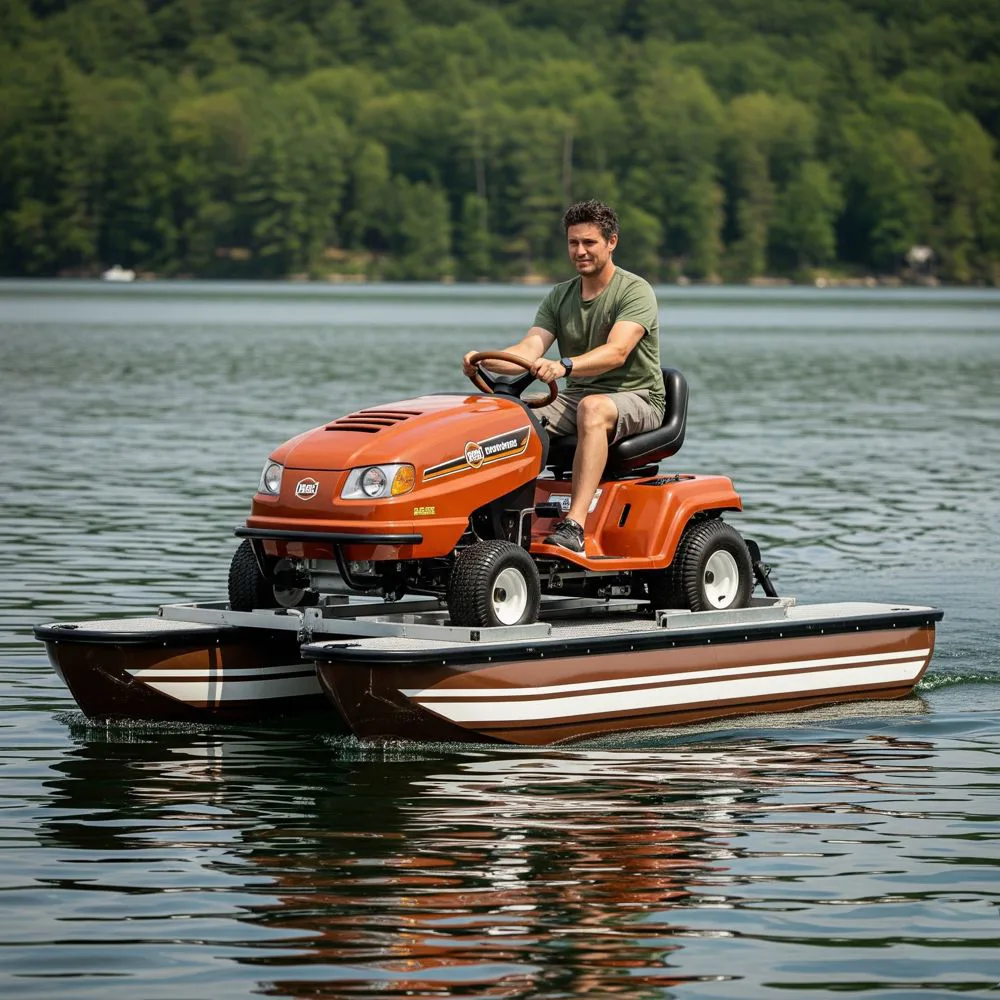
Buoyancy and Stability Requirements
Safety must remain the top priority throughout the design and construction process. Your lawnmower pontoon boat should provide adequate buoyancy to support maximum passenger load plus a significant safety margin. Most marine safety standards recommend buoyancy sufficient to support 150% of the boat’s maximum rated capacity.
Stability testing should be conducted in controlled conditions before taking passengers aboard. The boat should demonstrate positive stability when loaded to capacity and should not exhibit dangerous tendencies such as excessive rolling or difficulty returning to upright position after disturbance.
Legal Requirements and Registration
Boat registration requirements vary by jurisdiction, and homemade vessels may face additional scrutiny from marine authorities. Before launching your lawnmower pontoon boat, research local regulations regarding homemade watercraft. Some areas require inspection by certified marine surveyors before registration is granted.
Many jurisdictions classify boats by length and propulsion method, which affects registration requirements and operational restrictions. Your lawnmower pontoon boat will likely fall under small craft regulations, but specific requirements vary widely between different regions and governing bodies.
Essential Safety Equipment
Regardless of legal requirements, every lawnmower pontoon boat should carry essential safety equipment. Personal flotation devices for all passengers represent the absolute minimum safety requirement. Fire extinguishers become particularly important given the presence of fuel and ignition sources aboard the vessel.
Communication equipment such as waterproof radios or cellular phones can provide crucial emergency contact capability. Navigation lights may be required for operation during reduced visibility conditions. First aid supplies, bailers or bilge pumps, and basic tools for emergency repairs round out the essential safety equipment list.
Performance Optimization and Modifications
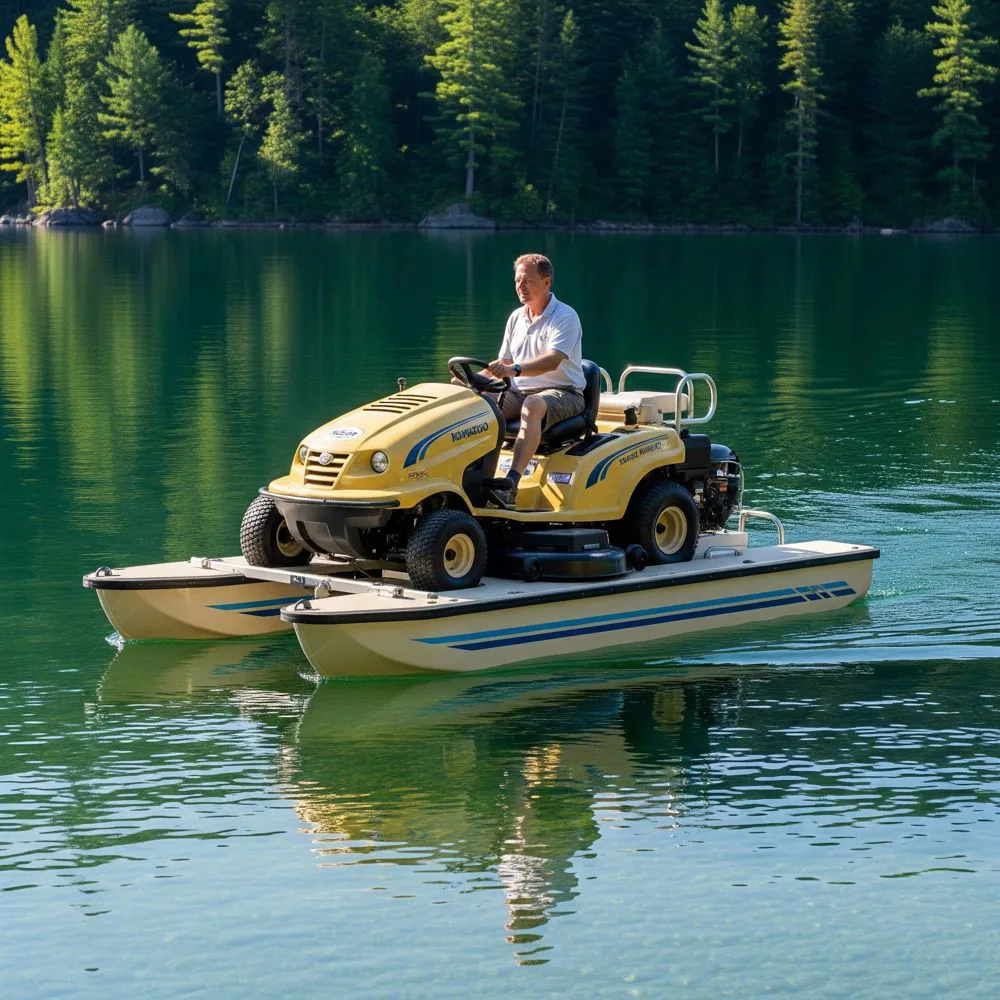
Engine Tuning and Maintenance
Achieving optimal performance from your lawnmower pontoon boat requires attention to engine tuning and maintenance. Marine environments present unique challenges including higher humidity, salt exposure, and continuous operation under load. Regular maintenance schedules should be established and followed religiously to ensure reliable operation.
Carburetor adjustments may be necessary to compensate for the different operating conditions compared to lawn mowing applications. Air filtration becomes more critical in marine environments, and upgrades to marine specific air cleaners can improve engine longevity and performance.
Hull Modifications for Better Performance
While basic pontoon platforms provide excellent stability, performance modifications can significantly improve speed and handling characteristics. Hull modifications might include adding spray rails to reduce water spray, installing trim tabs for better planing characteristics, or adding keels to improve directional stability.
Some builders experiment with pontoon spacing and size to optimize performance for their specific applications. Wider spacing generally improves stability but may reduce speed, while narrower configurations can increase top speed at the expense of initial stability.
Comfort and Convenience Upgrades
Extended time on the water calls for comfort and convenience features that make the experience more enjoyable. Comfortable seating represents the most important upgrade, as many builders start with basic bench seating that becomes uncomfortable during longer outings. Upgraded seats with proper back support and cushioning significantly improve the boating experience.
Storage compartments for personal items, fishing gear, or safety equipment add practical value to the vessel. Many builders install cooler compartments, rod holders, or equipment racks to support their preferred water activities. Simple additions like cup holders, non skid surfaces, and grab rails can greatly improve the overall user experience.
Cost Analysis and Budget Planning
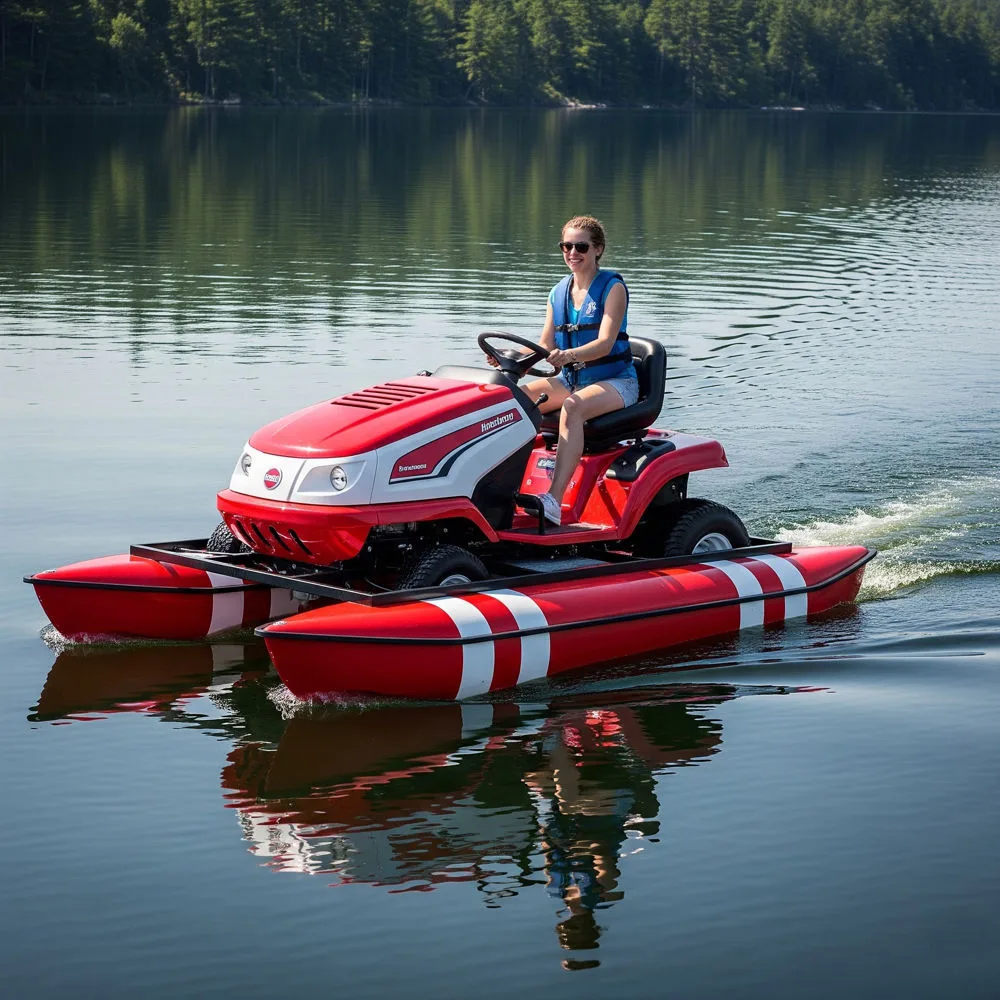
Initial Investment Requirements
Building a lawnmower pontoon boat typically requires a significantly smaller investment compared to purchasing a commercial boat of similar size and capability. The largest expense usually involves acquiring suitable pontoons, which can range from several hundred to several thousand dollars depending on size and material choice.
A used riding mower suitable for conversion can often be found for reasonable prices, particularly if cosmetic condition is not important since the mower will be extensively modified anyway. Additional costs include materials for frame construction, propulsion system components, and safety equipment required for legal operation.
Long Term Operating Costs
Operating costs for lawnmower pontoon boats remain relatively low due to their simple construction and readily available parts. Routine maintenance requirements mirror those of lawn mowers, meaning parts and service knowledge are widely available. Fuel consumption typically remains modest due to the relatively low power requirements for displacement speed operation.
Storage costs may be lower than traditional boats since many lawnmower pontoon boats can be easily disassembled for compact storage. Insurance costs vary but are often lower than traditional boats due to the reduced value and limited operating capabilities of most homebuilt vessels.
Value Retention and Resale Considerations
While lawnmower pontoon boats provide excellent recreational value, they should not be considered financial investments in the traditional sense. The homebuilt nature and unique design may limit resale appeal to a narrow market of enthusiasts. However, the low initial investment means that even modest resale values can provide reasonable cost recovery.
Many builders find that the construction experience and enjoyment derived from operating their creation far outweigh any financial considerations. The skills learned during construction often prove valuable for future projects and general mechanical knowledge development.
Creative Variations and Innovations
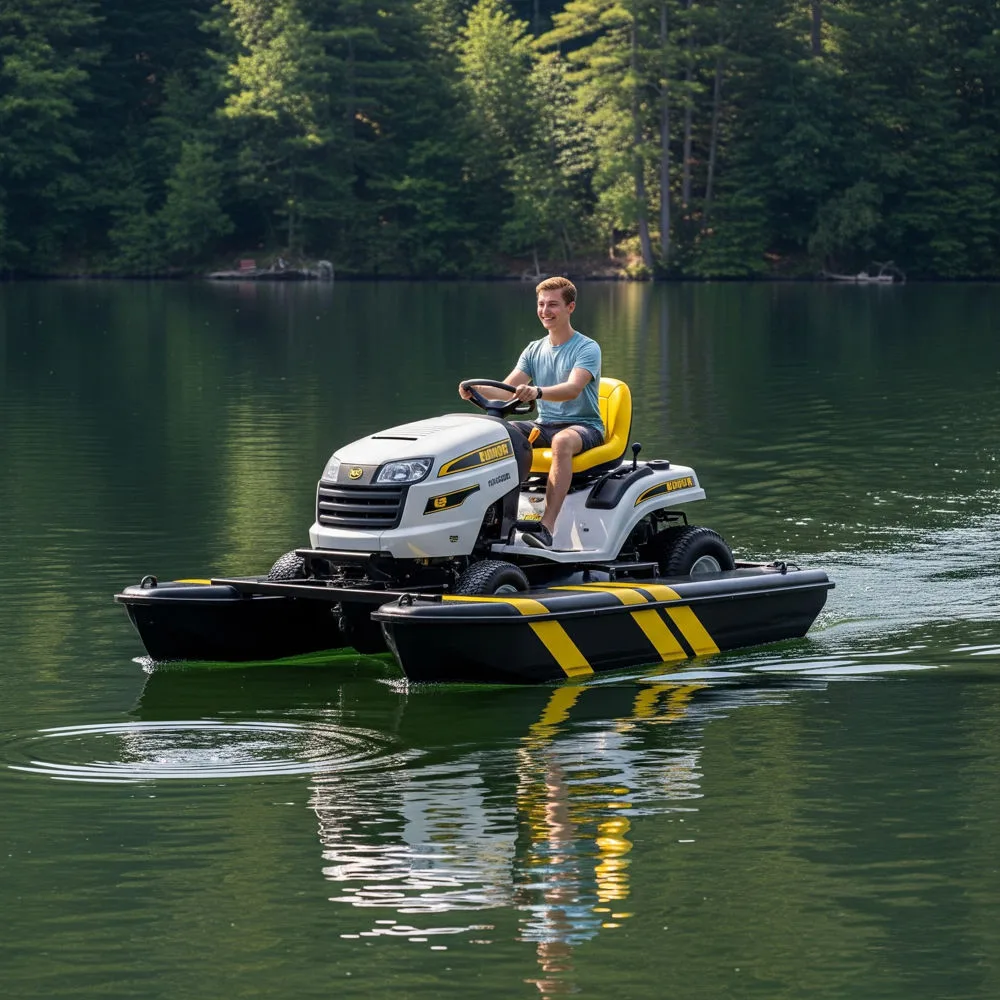
Themed and Decorated Designs
The DIY nature of lawnmower pontoon boats encourages creative expression through unique themes and decorative elements. Some builders create pirate ship themes complete with skull and crossbones flags, while others opt for fishing boat aesthetics with rod holders and tackle storage. Military themes, racing stripes, and custom paint jobs allow builders to express their personalities and interests.
Decorative elements should be chosen carefully to avoid compromising safety or performance. Lightweight materials work best, and any additions should be securely fastened to prevent them from becoming hazards during operation. LED lighting systems can add dramatic effects while providing practical illumination for evening operations.
Multi Purpose Platform Designs
Advanced builders often incorporate multiple functions into their lawnmower pontoon boat designs. Fishing platforms with built in rod holders, bait wells, and fish storage represent popular modifications. Some designs incorporate camping features such as canopy systems, sleeping areas, or cooking facilities for overnight adventures.
Work boat configurations might include crane systems for light lifting tasks, diving platforms for underwater activities, or research equipment mounting points for scientific applications. The versatility of the basic platform design allows for almost unlimited customization based on intended use.
Alternative Propulsion Systems
While traditional lawnmower engines provide the most straightforward propulsion solution, creative builders experiment with alternative power sources. Electric motor conversions offer quiet operation and environmental benefits, though battery capacity limitations may restrict operating range. Paddle wheel systems can provide unique aesthetics while delivering adequate performance for calm water operation.
Some builders incorporate auxiliary propulsion methods such as small outboard motors for backup power or higher speed operation. Sail systems can supplement mechanical propulsion for improved fuel economy and extended range capability.
Community and Resources
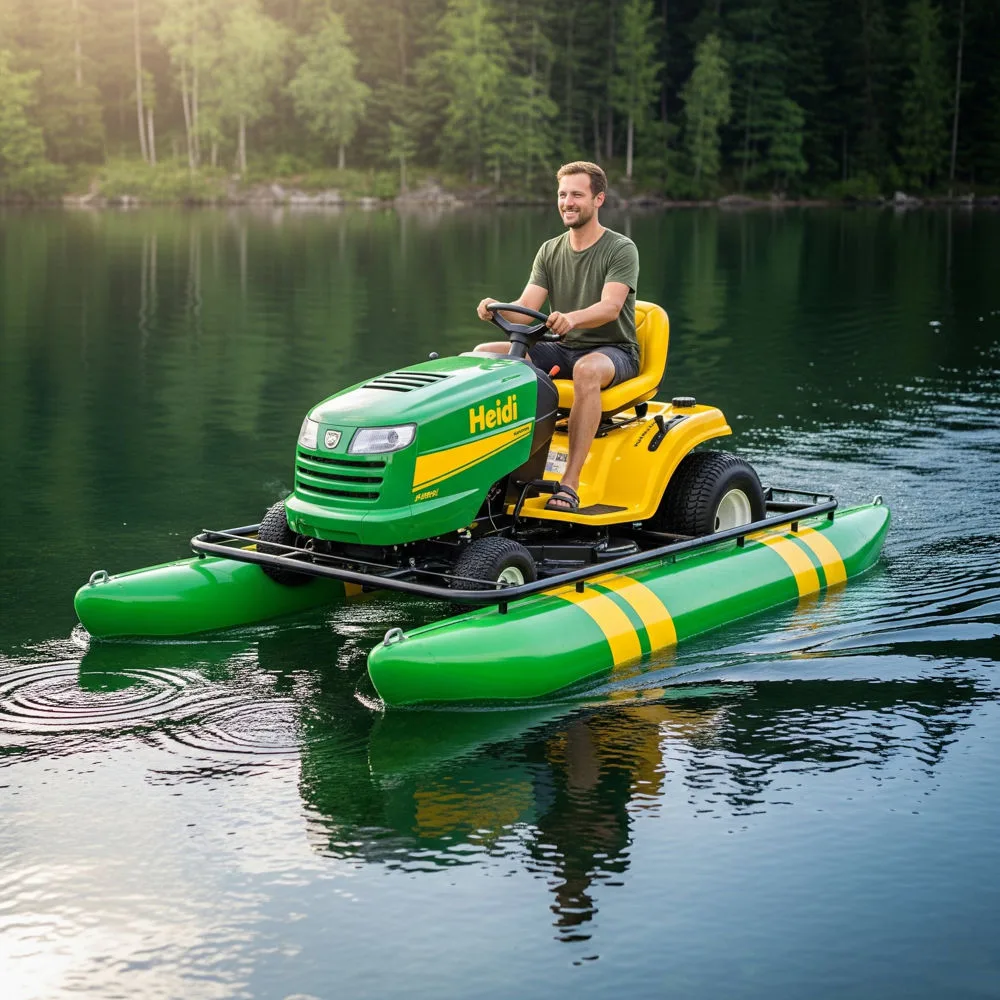
Online Communities and Forums
The lawnmower pontoon boat community has grown significantly with the rise of internet forums and social media groups. These online communities provide invaluable resources for builders at all skill levels, offering technical advice, design inspiration, and troubleshooting assistance. Experienced builders frequently share detailed build logs, parts sources, and lessons learned from their projects.
Video sharing platforms host numerous build documentaries and operational demonstrations that can provide visual guidance for complex construction techniques. These resources prove particularly valuable for first time builders who benefit from seeing actual construction processes rather than relying solely on written instructions.
Parts and Material Sources
Successful builds depend on sourcing quality materials and components at reasonable prices. Marine supply stores offer specialized components such as pontoons, propellers, and safety equipment, though prices may be higher than alternative sources. Salvage yards and used equipment dealers often provide cost effective sources for pontoons and marine hardware.
Online marketplaces have revolutionized parts sourcing for DIY boat builders, providing access to both new and used components from around the world. However, buyers should exercise caution when purchasing critical safety components from unknown sources, as quality and authenticity can vary significantly.
Events and Gatherings
Lawnmower pontoon boat events and gatherings provide opportunities for builders to showcase their creations, share experiences, and learn from fellow enthusiasts. These events often feature informal races, technical seminars, and social activities centered around the shared interest in creative watercraft.
Local boat shows and maker faires increasingly welcome unique homebuilt vessels, providing broader exposure for the hobby and opportunities to inspire new builders. Participation in these events helps build community connections and can provide valuable feedback for design improvements.
Conclusion
The lawnmower pontoon boat represents far more than just a quirky watercraft; it embodies the spirit of innovation, creativity, and resourcefulness that drives the best DIY projects. This unique vessel offers an accessible entry point into boat building and ownership while providing endless opportunities for customization and personal expression.
From the initial planning stages through final launch and beyond, building a lawnmower pontoon boat challenges creators to solve problems, learn new skills, and think creatively about repurposing everyday objects. The relatively low cost and straightforward construction techniques make this project accessible to builders with varying skill levels and budgets.
The growing community of lawnmower pontoon boat enthusiasts continues to push the boundaries of design and functionality, proving that innovation thrives when practical needs meet creative vision. Whether your goal is affordable recreation, a unique building challenge, or simply the satisfaction of creating something entirely your own, a lawnmower pontoon boat project offers rewards that extend far beyond the finished vessel.
Safety should always remain the highest priority throughout any boat building project, and proper planning, construction techniques, and equipment selection ensure that your creation provides years of safe, enjoyable operation. With careful attention to design principles, construction quality, and operational limitations, your lawnmower pontoon boat can deliver countless hours of unique recreational experiences while serving as a testament to your creativity and craftsmanship.
The journey from initial concept to successful launch represents just the beginning of your lawnmower pontoon boat adventure. Each trip on the water provides opportunities to refine the design, test new modifications, and share the joy of this unique watercraft with friends and family. In a world increasingly dominated by mass produced products, the handcrafted lawnmower pontoon boat stands as a proud example of individual creativity and the enduring appeal of building something extraordinary with your own hands.

